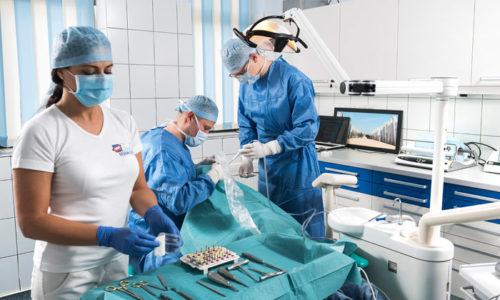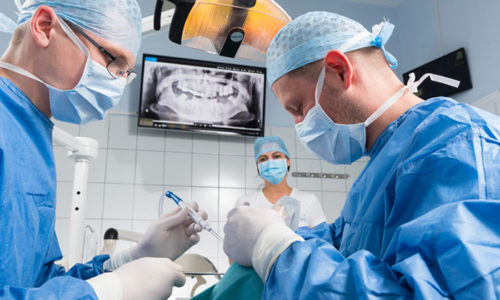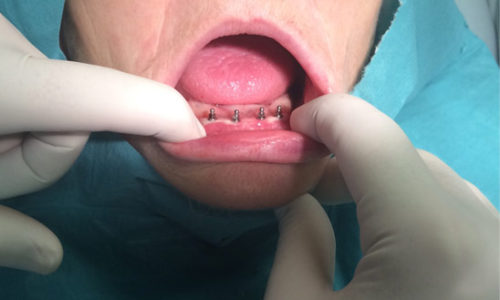Request an appointment!
After the tooth is removed, the tooth socket loses its original function (tooth holder function), then the soft tissues collapse, the bone part collapses and begins to become thinner. The volume of this bone mass becomes significantly smaller than those tissue conditions that form the dental structure having its own tooth. Earlier technologies made dental prostheses possible with the so-called bridges, but due to the advances in technology and medicine, dental implant is well-known now.
After the tooth is removed, the tooth socket loses its original function (tooth holder function), then the soft tissues collapse, the bone part collapses and begins to become thinner. The volume of this bone mass becomes significantly smaller than those tissue conditions that form the dental structure having its own tooth. Earlier technologies made dental prostheses possible with the so-called bridges, but due to the advances in technology and medicine, dental implant is well-known now.
The fact that grinding of other teeth is not needed for implants obviously supports dental implants and is against bridge prostheses. Another advantage of it is that with the help of implantation, even complete dentures can be replaced. These dental prostheses are fixed on the implant, non-removable, and much more capable to restore the original chewing ability than the removable dentures. Their use almost gives the same feeling as if they were our true teeth.
Dental implantation is recommended primarily for those for whom the different preservative dental methods, fillings are no longer a solution, or their various parodontal diseases can’t be stopped (it is not possible to retain the tooth). Unfortunately, in some cases the parodontal diseases are so overwhelmed that, despite all the fight, the tooth must be removed. These cases include the consequences of an accident, when the a tooth breaks, ruptures, and there is no way to rescue it.
As described above, the implantation should be inserted immediately after tooth removal. Of course, the basic state of bone must be clarified. It is best to insert the implant into a bone which is completely healthy and free from inflammation at that time.
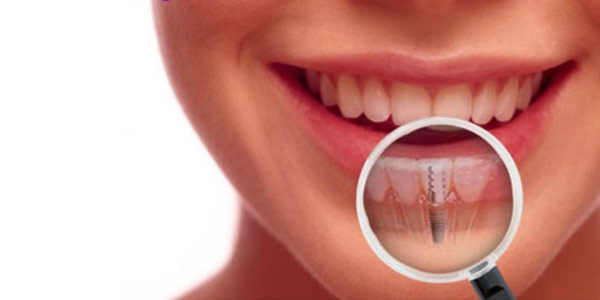
Bone Graft Before Implantation?
Basically, bone supply and anatomical regions determine the areas where implants can be inserted. If there is only a little bone, it is only possible to insert the implant partially. This has a long-term impact on the long-term wear of the implant. In this case it is necessary to replace the bone and to transform the anatomical regions a bit. This can be done with the patient’s own bone or with various synthetic bones. Particular anatomical deformations (e.g. the creek of the maxillary sinus in case of the upper molars and premolars) is seriously pneumatizing (they keep the air) for some patients, so the bone located here only minimally allows the implant to be received. In this case, we use the so-called sinus lifting surgery, since this bone mass should only be slightly increased.
For some cases, this isn’t always a separate operation, as during the insertion of the implant, it is possible to lift the mucous membrane of the maxillary sinus through the bone hole and to accumulate artificial bone material there. Otherwise, even when the shortest implant is inserted, a significant portion of the implant would be in the maxillary sinus, which would lead to the early loss of the implant and to the slide of the implant into the maxillary sinus.
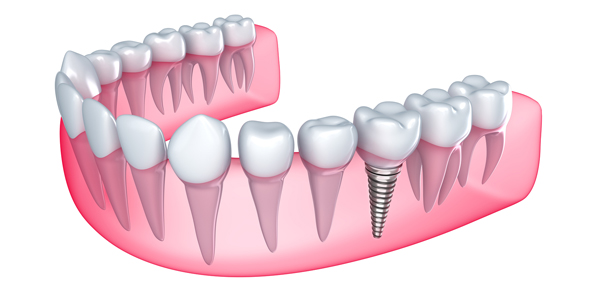

The so-called sinus lifting operation is a procedure which is performed with open technique, which means that after gum incision, the maxillary sinus wall at the oral vestibule side is gently uncovered, a bone window is made, and the mucous membrane of the maxillary sinus is lifted by a fine technique through this bone window. Synthetic bone under the lifted mucous membrane is collected and the implant is placed into this synthetic bone and to the little own bone material. Then, when the gum is healed, the dental prosthesis can be made to it. After the prosthesis is completed, the superstructure to be placed to the implant is also fixed. Using a screwing method, the head part is fixed to the inside of the implant, and the prosthesis or crown is fixed to the head part. There are two ways to do the latter, either by bonding or screwing again:
– if the bonding method is applied, practically the tooth cannot be removed from the head part, in this case the mucous membrane surrounding the implant can be accessed only by removing the crown.
– if a prosthesis with screw is applied, the dental prosthesis can be removed, so we can break this connection. Under the implant, the gum can be professionally cleaned, the tartar can be removed, then the prosthesis can be placed again to the implant.
We want to make your smile perfect!
Are you missing one or more teeth? We will examine the possibilities of installing the implant! Request an appointment!
Implant Insertion at Smile Design Center
Well-inserted and properly maintained implants are able to function for a lifetime in the oral cavity just like the original teeth. However, like as someone loses their own teeth, implants can be lost and it can happen even sooner in some uncontrolled and untreated cases. During daily tooth brushing, special attention should be paid to the tissue structures surrounding the implants and to the crowns and prostheses on the implants. It is not enough to apply simple brushing techniques; it is necessary to clean under and around the prostheses. There are several special tools for this.
We can use:
- standard dental gloss
- interdental brush
- special dental gloss which can be directed below bridges and around implants
- oral irrigator
- or, in case of regular control examinations, professional cleaning methods around interdental embrasures like scaling, sand blasting are available
We can say that modern electric toothbrushes have a very good cleansing effect in practice, but if one can properly use a manual toothbrush to clean the whole surface of teeth and prostheses, there is almost no difference between the effect of manual and electric toothbrushes.
What are the Cases where Dental Implant is Not Recommended?
If you have
- untreated high blood pressure
- untreated diabetes
- neoplastic disease
Dental implant is neither recommended for patients who have recently undergone chemotherapy or radiotherapy or are suffering from certain immune or hematopoietic disorders.
Patient Opinions
I went here yesterday for a filling change! It's true that my dentist, or more precisely my dentist, was different than before, but I think he is also a professional in dentistry, my teeth are better than when they were "new"! A 5* for Dr. Katalin Kaluja!
Pain is not part of the treatment, nor is humiliation. Certainly not here. I can only thank you for the soothing atmosphere, the positive attitude, the extraordinary precision and professional preparation, the many smiles and encouragement!
I thought for a long time about how to put into words my experience during and after the dental treatments, but I couldn't find the right words to express my gratitude and the gratitude I feel.
Good thing is that I did not feel anything from the whole procedure. The calm nature of the Doctor also reassured me in the dentist's chair. Additionally, filling and dental prostheses were needed, now all is done. No one can tell which is natural and which is artificial
The doctor is characterized by a high degree of professional preparation and precise, precise work! He is smiling, kind and patient with his patients, and the assistants are also helpful!
The nicest people I've ever met in a dental office work there. Their work is also first class. I can only recommend.
I thought for a long time about how to put into words my experience during and after the dental treatments, but I couldn't find the right words to express my gratitude and the gratitude I feel.
Pain is not part of the treatment, nor is humiliation. Certainly not here. I can only thank you for the soothing atmosphere, the positive attitude, the extraordinary precision and professional preparation, the many smiles and encouragement!
The doctor is characterized by a high degree of professional preparation and precise, precise work! He is smiling, kind and patient with his patients, and the assistants are also helpful!
Good thing I didn't feel any of it. The Doctor's calm nature also calmed me down in the dentist's chair. No one can tell which is the original and which is the replacement.
The nicest people I've ever met in a dental office work there. Their work is also first class. I can only recommend.
Tooth extraction is really painless! This is professionalism, Antal Sánta! I can only recommend it to everyone! Everyone is very kind and direct! 5 stars for me!

